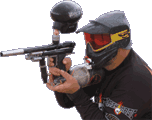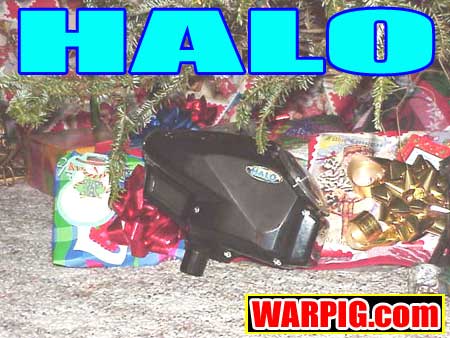  |
|
|
|
|
|
|
  |
|
|
|
|
|
|

Preview Manufactured
by
Testing Paint provided by: Field
Testing Performed At
HALO Video Clips online Hosted by Airgun Designs
What
do you think?
|

ODYSSEY HALO by Bill Mills December 2001
Late in the 2001 season prototypes made appearances at major tournaments, many in the hands of top name players like Chris LaSoya of Avalanche. The earliest prototypes were made of Stereo Lithography material. In stereo lithography a computer controlled laser literally draws a part in a polymer bath. The laser heats the polymer and turns it into a solid. A part that was designed completely in a CAD program can be turned into reality automatically.
The first handful of production HALOs were manufactured in late December 2001, and the first volume shipments to distributors are expected in early to mid January, 2002. The loader WARPIG received for review is a standard production model but is customized in one respect - one internal piece is molded (on the production mold) out of a white material instead of black to allow for better photography contrast.
In the front of the HALO, a phillips screwdriver is required to release the battery cover. The cover itself acts as a clamp locking the two loader halves together. In the rear of the loader is the control panel. It features a splash resistant flush pushbutton and a lens for an LED. This panel is separate from the two halves to allow for future electronic upgrades such as data displays to be integrated into a HALO without needing to replace the main body halves. The HALO is simple to operate. Pressing the button twice in a row flashes the LED in green and turns the HALO on. Pressing and holding the button for a full second flashes the LED red and turns the HALO off. The "double tap" to turn the loader on is designed to prevent accidental activation when the HALO is packed in a gear bag.
At the 2001 International Amateur Open another design change was made that found its way into the production HALOs. Odyssey's Chris Goddard recognized that occasionally one of the compartments on the drive cone would make a full revolution without catching a paintball. This would sometimes result in the paintgun skipping and firing a "blank" shot. Literally in the hotel room at the tournament Goddard modified a drive cone to only have two tabs rather than separate compartments. This way if there was a gap in the balls heading for the half pipe, the balls behind the gap would simply be pushed forward to fill it in.
Once the balls have been driven out
of the catch cup, they are held by a ball detent, waiting to be pushed
past it. A lever on the bottom of the HALO allows the detent to be
released to empty the HALO, and a slide latch allows it to be locked out
for slower feeding paintguns. In the feed neck the balls wait in
a stack to fall into the paintgun. An infrared LED and sensor bounces
a signal off of one of the balls in the stack.
So, with nearly a year of field testing prototypes at the professional tournament level, and with a number of paintgun manufacturers, the HALO has been tuned to the point that Odyssey feels it is ready for release.
There have been a lot of variances in what has been considered the "standard" feed neck size for paintball hoppers. The HALO would be considered "large" and required sanding to fit in a Matrix for testing. The drive train on the HALO does make a bit of noise, and is comparable to the early model Ricochet 2K loaders. Because the entire gear set and bushings are accessible, it is possible to keep them lubricated to reduce sound, and future drive train upgrades may include bearing sets for better speed and or less noise.
Moreover, the HALO still fed when tilted past 60 degrees, as long as the level of balls in the hopper reached the catch cup and there was enough angle to roll balls down the feed neck to the paintgun. For front players and crawlers, the ability to feed when the paintgun is nearly laying on it's side is a definite plus. It was also noted in field use, that the noise of the loader was not significant compared to the noise of a paintgun, even the Matrix which is relatively quiet. Additional testing was performed with drop tests allowing the hopper to empty itself with old, out of round paintballs to test for jams and reliability. The HALO handled the old paint without incident. An internal jam test was performed to check for the possibility of paintballs jamming between the drive cone and half pipe. The test consisted of attaching the HALO to a Warp Feed and running the Warp Feed hose back to the HALO. On this test stand the HALO was run for 10 minutes of continuous operation with Diablo Blaze paint, and did not jam, or allow any gaps in the ball stack long enough to reach into the Warp Feed (which would have been a skipped shots on a paintgun). The Highly Advanced Loader Operations
(HALO) hopper represents another step forward in loader technology and
is sure to be one of the "hot" products of the 2002 season.
|
| Copyright © 1992-2019
Corinthian Media Services. WARPIG's webmasters can be reached through our feedback form. All articles and images are copyrighted and may not be redistributed without the written permission of their original creators and Corinthian Media Services. The WARPIG paintball page is a collection of information and pointers to sources from around the internet and other locations. As such, Corinthian Media Services makes no claims to the trustworthiness or reliability of said information. The information contained in, and referenced by WARPIG, should not be used as a substitute for safety information from trained professionals in the paintball industry. |